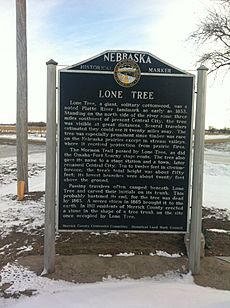Lone Tree Monument facts for kids
 |
|
| Coordinates | 41°4′26.4″N 98°1′22.2″W / 41.074000°N 98.022833°W |
|---|---|
| Location | Central City, Nebraska |
| Designer | Residents of Merrick County (1911) |
| Material | granite |
| Height | 10 feet |
| Completion date | August 9, 1911 |
| Dedicated to | Lone Tree |
| Behind the granite monument stands a live cottonwood tree signifying the original cottonwood tree. | |
The Lone Tree Monument marks the spot where a very important tree once stood in central Nebraska. Long ago, Native American leaders met under this tree. Early pioneers also used it to find their way. The tree was so famous that the first name of Central City (the main town in Merrick County) was 'Lone Tree'. Today, the Nebraska State Historical Society recognizes this spot as a special historical place.
Contents
The Story of the Lone Tree
The original Lone Tree was a huge cottonwood tree. It grew on the north side of the Platte River. This was about three miles southwest of where Central City is now. The tree's trunk was about 10 to 12 feet around at the bottom. It stood about 50 feet tall. Early travelers said they could see this landmark from 20 miles away across the wide prairie.
The Tree's Importance
Native Americans knew this tree well. They had their own name for it, though we don't know what it was. Stories say that Native American chiefs held important meetings under its cool shade.
Pioneers started using the tree as a landmark as early as 1833. In 1858, a company called Western Stage Co. chose this spot for their Lone Tree Station. This station was built and running from 1860 to 1861. It was even a stop for the famous Pony Express. A woman named Mary Hilton managed the station during those years.
In 1858, the Nebraska Territorial Legislature officially created Merrick County. They named a place called "Elvira" as the county seat. This "Elvira" was a made-up town located right under the Lone Tree.
The Great Storm of 1865
Sadly, the Lone Tree died in 1863. Then, in 1865, a big storm blew the dead tree over. People believe two things caused the tree to weaken. First, pioneers traveling along the Overland Trail and Mormon Trail often carved their names into its bark. This slowly hurt the tree. Second, travelers often built campfires at the base of the tree. This might have damaged its roots and trunk even more.
After the tree fell, part of its trunk was moved. It was taken to the Lone Tree station, which later became Central City. This piece of the trunk was placed on the depot platform. Over time, visitors took small pieces of it as souvenirs. Eventually, the entire trunk disappeared.
From Lone Tree to Central City
In 1866, the made-up county seat of Elvira finally got a real location. A town was built there and named "Lone Tree." This town was later renamed "Central City" in 1875.
The 1911 Monument
Even though the original Lone Tree was long gone, the people of Merrick County never forgot its history. In 1911, they decided to build a monument. They put up a granite monument to remember the famous tree. Thirty years later, another cottonwood tree was planted right next to the granite monument. This new tree stands where the original Lone Tree once grew. The monument was officially dedicated on August 9, 1911. A second dedication ceremony took place on July 3, 2011.
Images for kids



